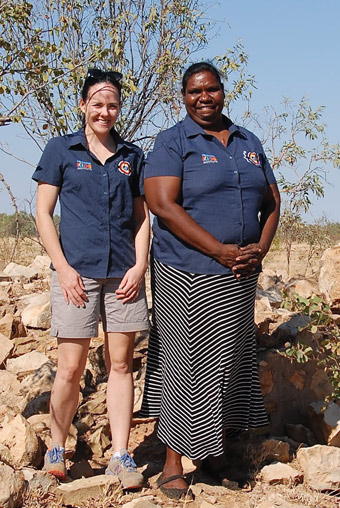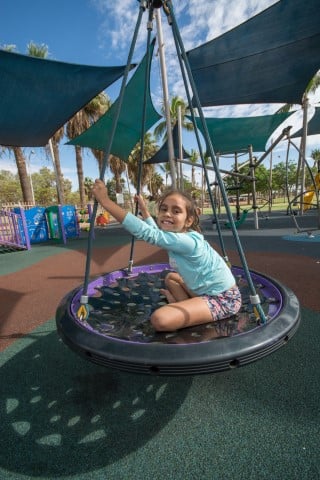Researchers from The Kids Research Institute Australia are relying upon the local knowledge of Aboriginal women from the remote Fitzroy Valley region to run a school program designed to help children, including those with FASD, adjust their levels of alertness and attention in the classroom.
Have you ever thought about why you reach for that cup of tea before going into a meeting?
Rather than simply enjoying the taste or needing the caffeine hit, it could be that bringing the cup to your mouth and taking a sip is helping you become more alert or getting into ‘just the right gear’ for listening.
It is this philosophy that underpins the Alert Program® Study which is led by Dr James Fitzpatrick, Head of the Alcohol, Pregnancy and Fetal Alcohol Spectrum Disorders Research Group.
Study coordinator Bree Wagner said the program taught children their bodies functioned like a car engine and how to adjust their levels of alertness, or ‘change gears’.
“Like a car you can be in high gear, which is when you are feeling hyped up or agitated, or low gear where you might be feeling lethargic, droopy, tired or flat,” Ms Wagner said.
“The goal is to get kids’ engines into just the right gear for learning in the classroom where they are alert, attentive and focused.
“The program is really flexible so you can adapt the way you teach it or describe the concepts to suit the particular setting that you are working in.”

Ms Wagner and her team at the Institute worked with the program developers, local occupational therapists and teachers to modify it to suit a school setting so it could be taught as a series of lessons. They are currently in the process of implementing the Alert Program® in nine remote schools across the Fitzroy Valley in the Kimberley region of Western Australia.
“We hope that it makes a difference to the kids’ skills, so they can engage with learning, and therefore improve their educational outcomes for the future,” Ms Wagner said. “And carry those skills over to their post-school lives because they’re skills we all use every day.
“We are building capacity in teachers and support staff, such as Aboriginal education officers and education assistants, to deliver a curriculum version of the Alert Program®. Then we are measuring the outcomes for the children before, after and at follow-up.”
While all children attending primary school in the Fitzroy Valley will receive the program, the study will also investigate if the program is also a potential intervention option for children with FASD.
“Kids with FASD often have greater problems with attention, their memory and problem-solving skills,” Ms Wagner said. “Using different sensory strategies like having something in your hand to fidget with, or chewing and working your muscles can be regulating.”
Adults automatically used sensory strategies like having a cup of tea - a tool for the mouth - or fidgeting with their pens - a tool for their hands - to self-regulate.
“As adults no one thinks twice about doing these things,” Ms Wagner said.
“But in the classroom, kids will often need to get some movement, and they’re not going to just hold on to the chair and do something subtle, they might get up and run around. That’s really distracting to other kids and the teacher could think that’s bad behaviour.”
A group of Aboriginal women from the Fitzroy region have been employed as community researchers on the project.
“The community researchers have been integral to fostering relationships between researchers and community members, providing cultural guidance and language support and working in a two-way partnership to run the project,” Ms Wagner said.
Muludja Community woman Sue Cherel is lead community researcher on the project. She has already seen the difference the program can make, not only in the classroom, but in the home as well.
“We did a workshop with parents so they could understand why kids were playing up and getting in trouble as well,” Ms Cherel said. “We have seen a difference from the teachers and the parents getting to better understand their children. A better connection with their children. So when the kids go back home they understand what the kids are talking about, like whether their engine is high or low.”
Ms Cherel said people in her community lived close to each other, and improvements in relationships and behaviour had been noticeable.
“In my community everything is much better now,” she said. “The kids know what to do when they are feeling bored, or feeling high or low.
“The kids know you aren’t always just right. They learn you have to be in high gear if you are going to the football, you have to be in high gear to cheer for your team. But not in the classroom.”
Ms Wagner said the community researchers, from four Aboriginal language groups, were equally as important to the success of the project as Institute staff.
“Without their support and their guidance, the project would not be able to be what it is,” she said.

“We are able to share our knowledge around research, the project and the science, but we rely heavily on our community researchers to provide their knowledge and expertise around language, around cultural protocols, how to build relationships with communities, and introducing us to families.”
For now, teachers in these communities are learning how to recognise when children are in high and low gear and strategies to help them switch – like doing chair push-ups or wriggling on a cushion.
The program could turn traditional teaching methods in schools upside down.
“Teachers need to be in tune with the kids to know what strategies will work for different kids and offer them more class-appropriate strategies than perhaps the kids will choose themselves,” Ms Wagner said.
Rather than seeing a child that cannot sit still as naughty, it’s about realising they might need a less disruptive method for switching gears.
What’s next?
Analysis of the findings in 2018 will allow the team to prepare guidelines for the use of the Alert Program® with children who have impairments in self-regulation and executive functioning in similar settings.
100 Women is supporting the empowerment of Aboriginal community researchers on this project through training and development opportunities.
